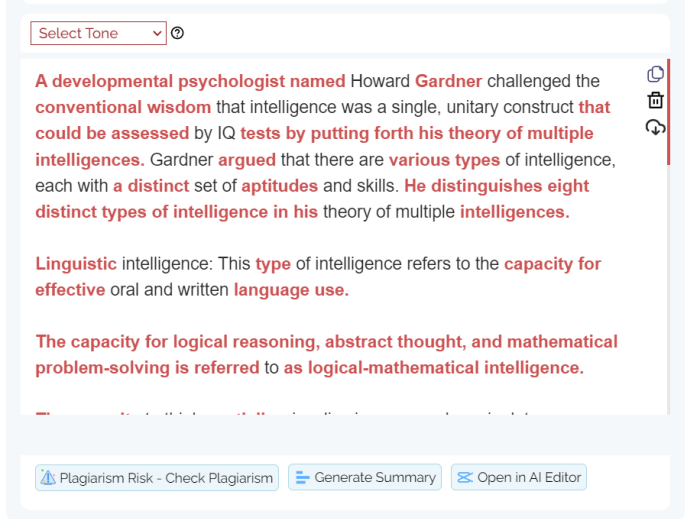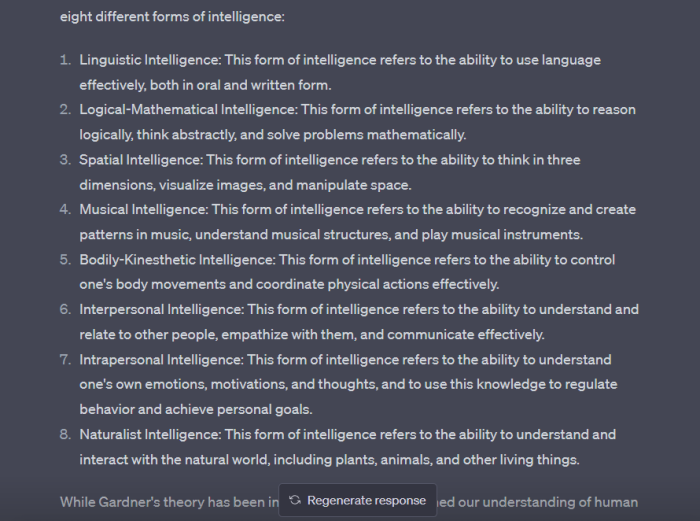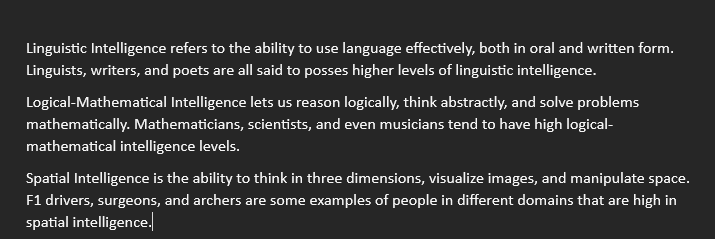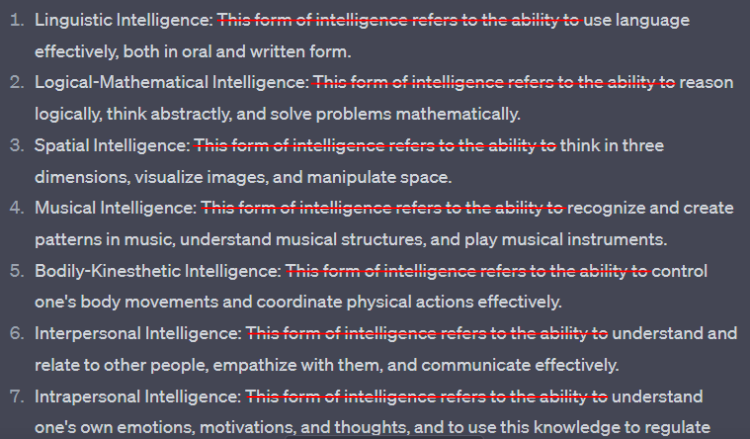What to know
- Never turn in AI-generated text without making changes to it.
- Use tools such as Quillbot, Paraphrasing Tool, and Jasper to change the wording of the text.
- Change the phrases, sentences, and other elements of the text yourself.
- Prompt ChatGPT to rewrite its own text and revise through multiple drafts.
ChatGPT is a technological marvel. It generates images, writes pretty prose, programs, and does everything that a friendly chatbot ought to do. But if you’re using it to send in school essays or other write-outs, you should be a little wary of AI detectors that have emerged in its wake.
Because AI text generators are pioneers and detectors are playing catchup, the cat-and-mouse game that teachers and students engage in favors students more. But even then, it’s not as simple as entering the essay question and going with the first draft that ChatGPT spews out. You will be found out.
It’s better, then, to put in a little bit of work, refine the ChatGPT text with different drafts, use AI rewriter tools, and tinker and tweak the text yourself enough to pass through both artificial and human detectors. This guide will help you with all such little tricks to rewrite and own the ChatGPT-generated content so it is truly indistinguishable from if you had written the text yourself.
What makes AI writing AI?
Depending on which side of the aisle you find yourself, you may already have used ChatGPT to do your work or AI detectors to catch if that’s been done. But anyone who’s read through AI-written content, regardless of their education qualification, would know that its language sounds off. This is truer for long-form essays and articles than conversational texts or instructional queries.
Exactly how and why it is off and unnatural is a little like trying to point out where one color ends and another begins in a rainbow. Sure, grammar is never a concern with ChatGPT or other similar AI tools. But there is more to writing than grammar alone.
Human writing is stamped with the personality of its author and finds its way in the words we use and the sentences we create. Our emotions and motivations guide our hand to run on in the search of an idea, the perfect turn of phrase, or flit from fancy to fancy, all of which are very natural tools and tricks of the trade that come naturally to us, but may not be readily available to AI. Very human things like one’s proclivities, prejudices, and biases inevitably end up in the human expression, something your professors are sure to notice.
Hallmarks of AI Writing
To better categorize what AI lacks, here are the hallmarks of what makes AI writing sound artificial and contrived and what you should avoid having in your ChatGPT text.
Rigid consistency – AI writing is consistent to a fault. It tends to follow the high-school blueprint of writing essays, which goes – Say what you’re going to say, say it, say what you said. This is alright, but can be done to the point of rigidity. The lengths of different paragraphs making different points remain more or less the same, no matter if you’re you’re writing argumentative essays or expositions. This suggests that it gives equal value to different points, even on divisive and polemic topics. It’s a clear giveaway.
Repetitive phrasing – In essays and long-form writing, good phrasing emphasizes the point being made, adds color and nuance to it, and keeps the reader from being bored to death. But AI tools seldom use them variedly, and muscle in the same stock words and phrases in the text to emphasize a point.
No leaps of imagination – AI doesn’t daydream or count electric sheep, not that we know of, and is not prone to flights of fancy as ourselves. It’s rational, logical, and doesn’t waste words on purple prose. This inability to tap into this creative pathos prevents it from making lateral and divergent connections between seemingly disparate ideas and writing evocative content. Very rarely would one be able to glean flashes of inspiration in its generated text.
Un-natural and generic language – GPT’s training data comes from a wide number of sources, and has to be synthesized and summarized to serve the lowest common denominator, making it sound very generic. This is not suited to high school or professional writing where students are expected to critically analyze and offer intelligent perspectives on events.
Some of these issues can be fixed with better prompting and revising. But more often than not, you will have to intervene and add your own flair to liven it up.
How to rewrite AI-generated text
Whether you’re short on time or ideas, GPT-based AI text models are your friend. But to keep professors from detecting any AI in your work, you’ll have to consider its first response as just a first draft which will have to be reworded and rephrased with the help of other AI tools and on your own. Here are the general steps on how this can be done…
For demonstration purposes, we’ll use the following sample essay question: Critically analyze and comment on the different forms of intelligence as given by H. Gardner.
1. Use a Rewording or Rephrasing tool
First responses, no matter how professional they look, are drafts that have to be reworded. The easiest way to do this is to use a rephrasing tool. There are many such tools; pick one from the list below, enter the text, and rephrase:
- Quillbot
- Paraphrasing Tool
- Copy AI
- Hypotenuse AI
- Rewording
- Frase
- Scribbr
- Paraphraser
- Jasper
- Rephrase
All these tools are free to use and can save a lot of time and effort if you’re not sure of your knowledge on the topic, or your linguistic skills.

The one that we recommend is the Paraphrasing Tool shown above. Besides simple paraphrasing, it gives you half a dozen other options, such as ‘Text Improve’, ‘Creative’, ‘Near Human’, and ‘Plagiarism Remover’, etc. The paraphrased text is also highlighted in red so you can easily see which words or sentences the tool has changed.
2. Edit it yourself to remove AI and add human personality
The best thing to do, if you do have the time, is to edit and rewrite ChatGPT-generated text yourself. You don’t have to be a grammatical pedant for it; if you’ve written essays before, it’s all the qualification you need. Here are some things you can try:
i. Validate and Edit
When editing any text, first read through it to validate its claims. ChatGPT is not always right, nor are there any fact-checkers for it. It also does not know right from wrong which is purely a human domain. If you have some knowledge of the topic, make sure to edit out any claims that are plainly incorrect.
In our example, we found that ChatGPT didn’t mention the ninth ‘Existential’ intelligence type which was also given by Gardner. So we will have to add that in.

ii. Edit big, then small
Editors know there’s no point in splitting hairs at the word level when the sentence or paragraph is skewed. So briefly glance down the text and look for any big changes that you’d like to make such as shortening or fattening a paragraph, reorganizing it, and deleting sentences you don’t want included.
Our draft mentioned the different forms of intelligence as bulleted points with one-sentence explanations. We’d rather dedicate small paragraphs to each, with examples to back them up.

iii. Line editing, syntax, and rewording
Once bigger changes are made, you can set out to refine the phrases used, use your own diction, and change the order of words, and check for flow and readability. This is perhaps the biggest change you will make to ChatGPT-written content. In our example, ChatGPT began all sentences for the different intelligences with the stock phrase ‘This form of intelligence refers to the ability to…‘, and did so for every single one of them.

ChatGPT also likes to use sign-post words a lot, such as initially, subsequently, moreover, however, etc., especially in history essays. Once or twice is fine, but no good student would be so liberal in littering his/her essay with such adverbs.

It’s best to either use a different way to start a sentence or just delete them completely. If the information is well put together, more often than not, you won’t need to have such weasel words anyway.
You may also want to add clauses, write caveats in parentheses, or include modal verbs (like can, could, may, might, etc.) which are indicative of a thinking mind that’s aware of the limitations of the claim.
iv. Change beginnings and endings
The meat of the matter is the middle. But beginnings and endings are where you really get to stamp your personality on the text and offer your unique perspective. If there is nothing else that you want to change, at least change the beginnings and endings, for that is how you hook the reader in and leave them with some insight that they wouldn’t have had had they not read your piece.
3. Use ChatGPT again to rewrite the text
Another great option if you have some time, but not enough to make the changes manually, is to prompt ChatGPT (or whichever AI tool you’re using) to rewrite the text in a different way. Some of these can include the following:
Rewrite and make it better – A very general rewriting prompt, but one that can work well if you’re not sure exactly what changes to make.
Rewrite with better clarity – Such a prompt will simplify the language and make the sentences easier to understand, even if it is at the expense of nuance.
Rewrite to improve grammar – If your own text suffers from grammatical errors, use this prompt to fix and refine your writing.
Rewrite with authority – Depending on the type of writing, you can improve the authority of a piece by prompting ChatGPT for it. Just make sure ChatGPT doesn’t claim anything that is not verifiable.
Rewrite to impress – This prompt works great if you want to sound literate and bookish. This will take sentence complexity and word choice up a notch without compromising on the main gist of the original text.
Rewrite creatively – Prompting ChatGPT to be more creative will cause it to ditch stock phrases and sentences for variety and natural-sounding tones. Though not always on the mark, you can regenerate responses with the same prompt until you hit on one that works for you.
Rewrite elegantly – This prompt is similar to ‘rewriting to impress’, with the slight difference that the sentences are a little less convoluted and flow appreciably better from one to the next.
Some tips
While rewriting, whether doing it with rephrasing tools, ChatGPT, or by yourself, there are a few things you should take note of.
Firstly, look for similarities between the original ChatGPT draft and your final rewritten copy. Open them up side by side and find areas that could be made better and unique.
Secondly, be on the lookout for stock phrases that have been repeated multiple times and minimize them. Take assistance from rephrasing tools or ChatGPT prompts to rewrite those sections separately.
Always check the validity of the claims made by ChatGPT. You don’t want your professors reprimanding you for writing things untrue or factually incorrect.
FAQ
Let’s take a look at a few commonly asked questions about rewriting content generated by ChatGPT and other such AI chatbots.
How do I edit AI-generated text?
AI-generated text can be edited in a few ways – by using rephrasing tools like Quillbot, asking ChatGPT to rewrite the text, or doing so yourself. The latter is the best way as it will naturally infuse your own personality into the text, but it can also take up some time.
What is the tool to rephrase text?
There are various free tools to rephrase and reword text available online. These include the likes of Quillbot, Jasper, Copy.AI, etc.
How do you change the wording of a paragraph?
To change the wording of a paragraph, pay attention to three things – phrases, sentence length and variation, and word choices. Replace common-sounding phrases with your own. Vary the length of the sentences in a paragraph to break the monotony, and change important words with their synonyms.
ChatGPT’s first response to your question prompt should never be seen as the final copy. Before you turn it in, make changes to the text yourself, if you have the time. If you don’t, take assistance from rephrasing and rewording tools or ask ChatGPT to rewrite the text in a better way.
We hope this guide helped you understand how you can go about taking an AI-generated essay or article and making it your own. Happy editing!





